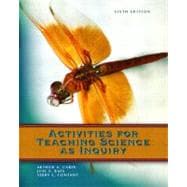
| Using Activities for Inquiry | |
| Engaging Students in Inquiry | |
| Use Well-Designed and Proven Activities | |
| Sequencing Science Instruction and Inquiry | |
| Lesson Plan: An Inquiry into Pendulums | |
| Cooperative Learning | |
| How Text Activities Are Organized | |
| References | |
| Physical Science Activities | |
| Matter and Energy | |
| Thermal Energy (Heat) | |
| Air Pressure. Sound Energy | |
| Simple Machines (Mechanics) | |
| Magnetic and Electrical Energies and Interactions | |
| Light Energy, Shadows, Lenses, and Color | |
| Life, Ecology, and Environmental Science Activities | |
| Plant Anatomy and Physiology | |
| Animal Anatomy and Physiology | |
| Human Anatomy, Physiology, Nutrition, and Health | |
| Ecology and the Environment | |
| Earth and Space Science Activities | |
| Astronomy (Earth in Space) | |
| Meteorology (Weather) | |
| Geology (Earth's Changing Surface) | |
| Inquiry Science Activities for Students with Special Needs | |
| Students with Blindness or Vision Impairments | |
| Students with Developmental Delays | |
| Students with Visual Perception Problems | |
| Students with Emotional Disorders | |
| Students with Deafness or Hearing Impairments | |
| Table of Contents provided by Publisher. All Rights Reserved. |
The New copy of this book will include any supplemental materials advertised. Please check the title of the book to determine if it should include any access cards, study guides, lab manuals, CDs, etc.
The Used, Rental and eBook copies of this book are not guaranteed to include any supplemental materials. Typically, only the book itself is included. This is true even if the title states it includes any access cards, study guides, lab manuals, CDs, etc.